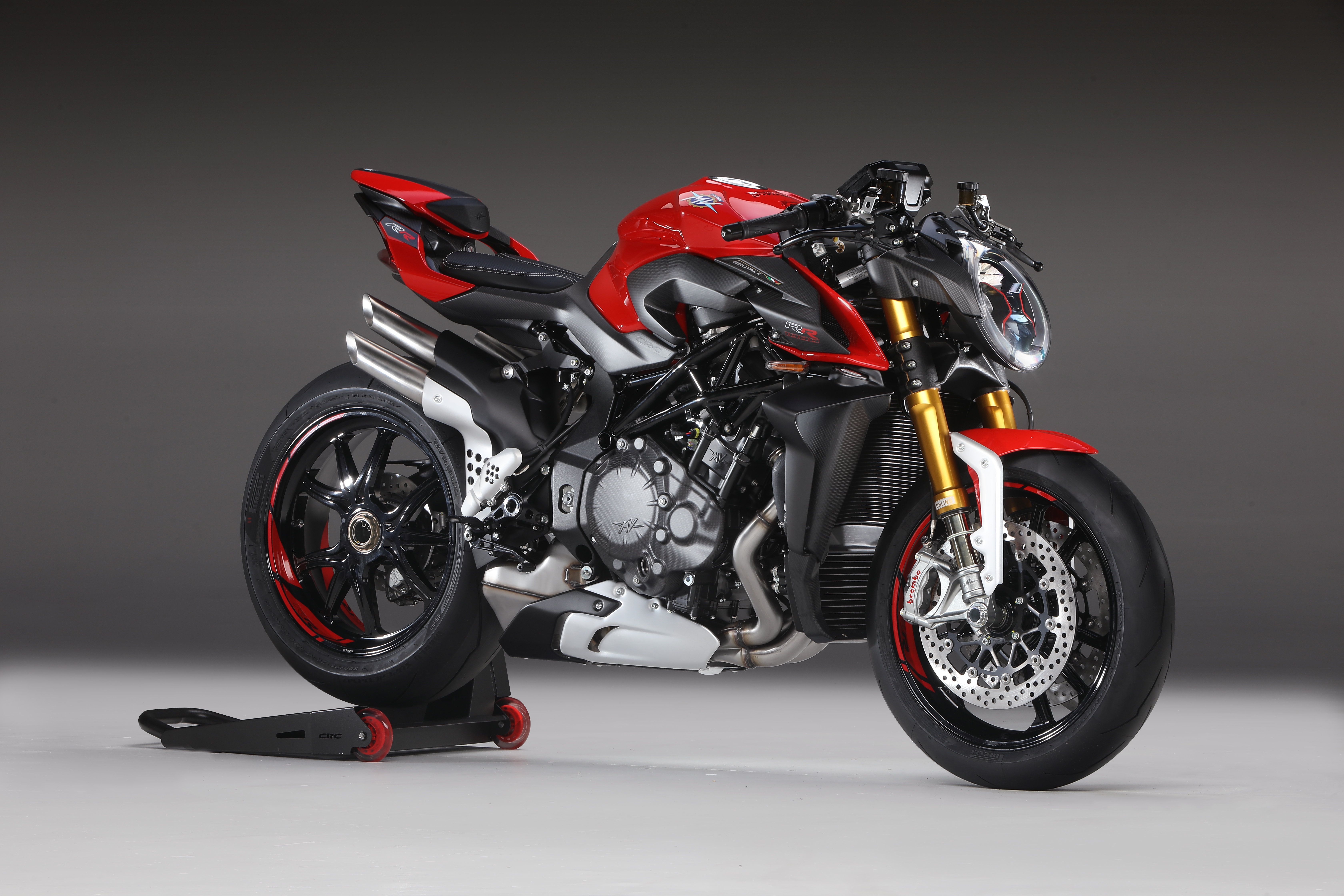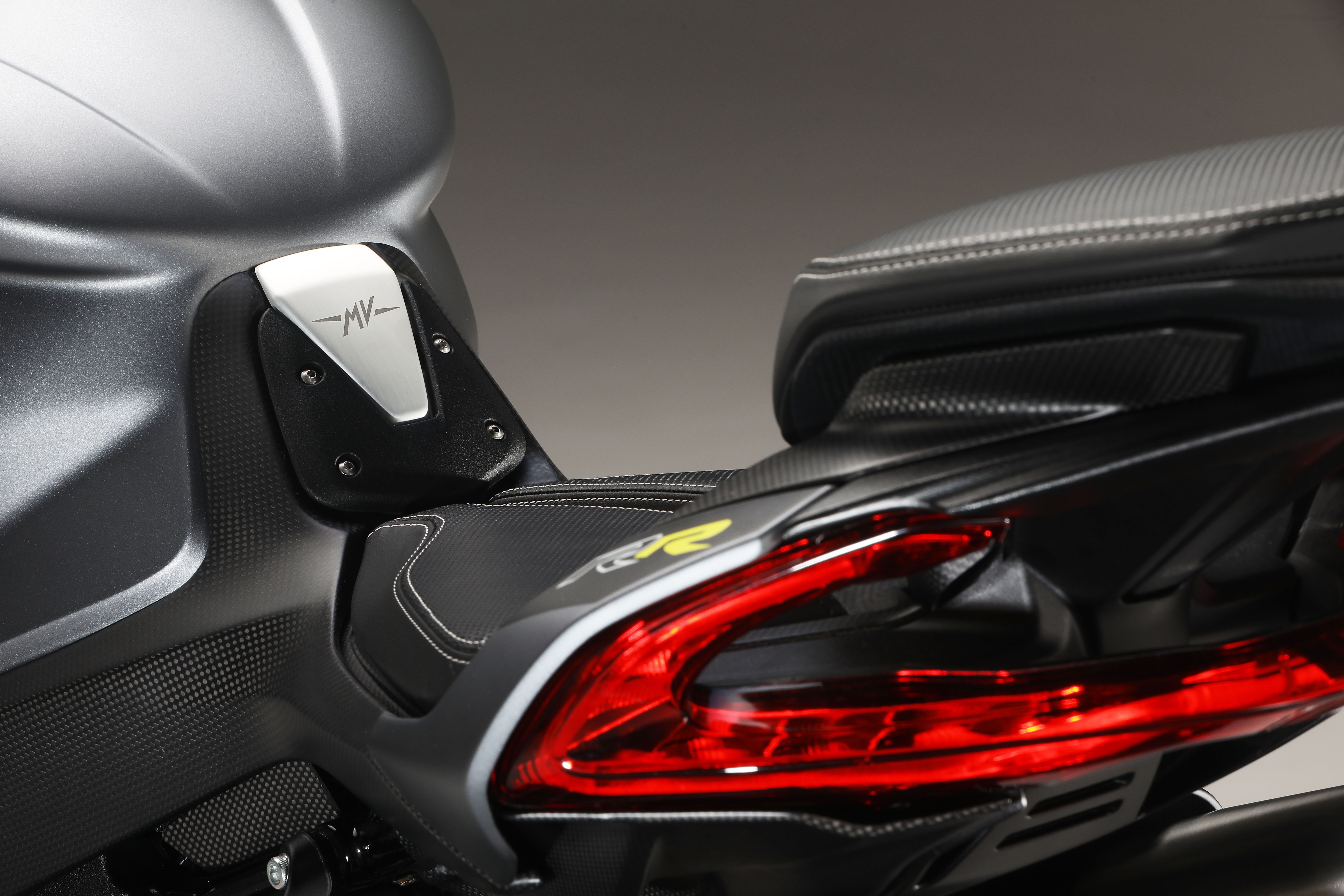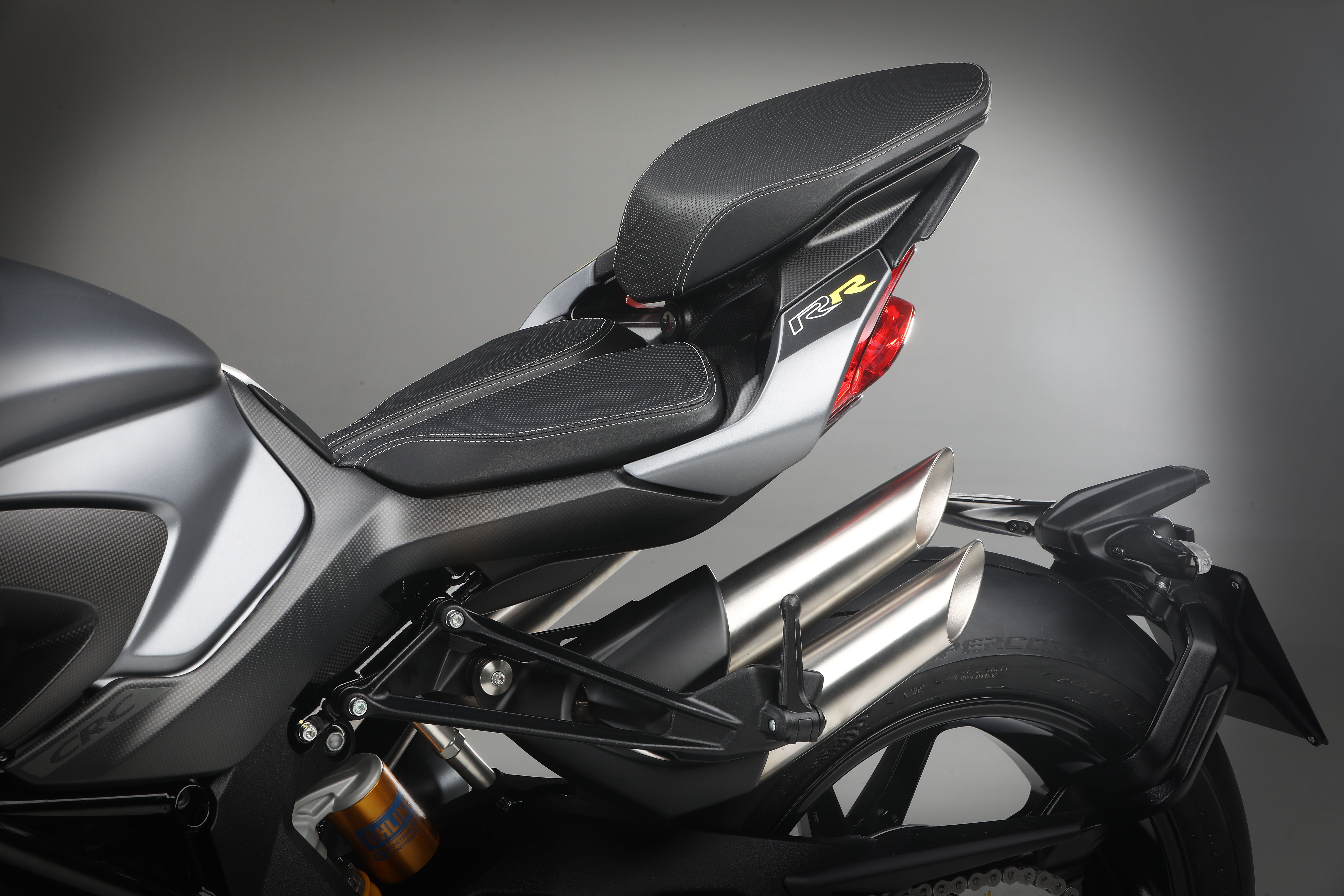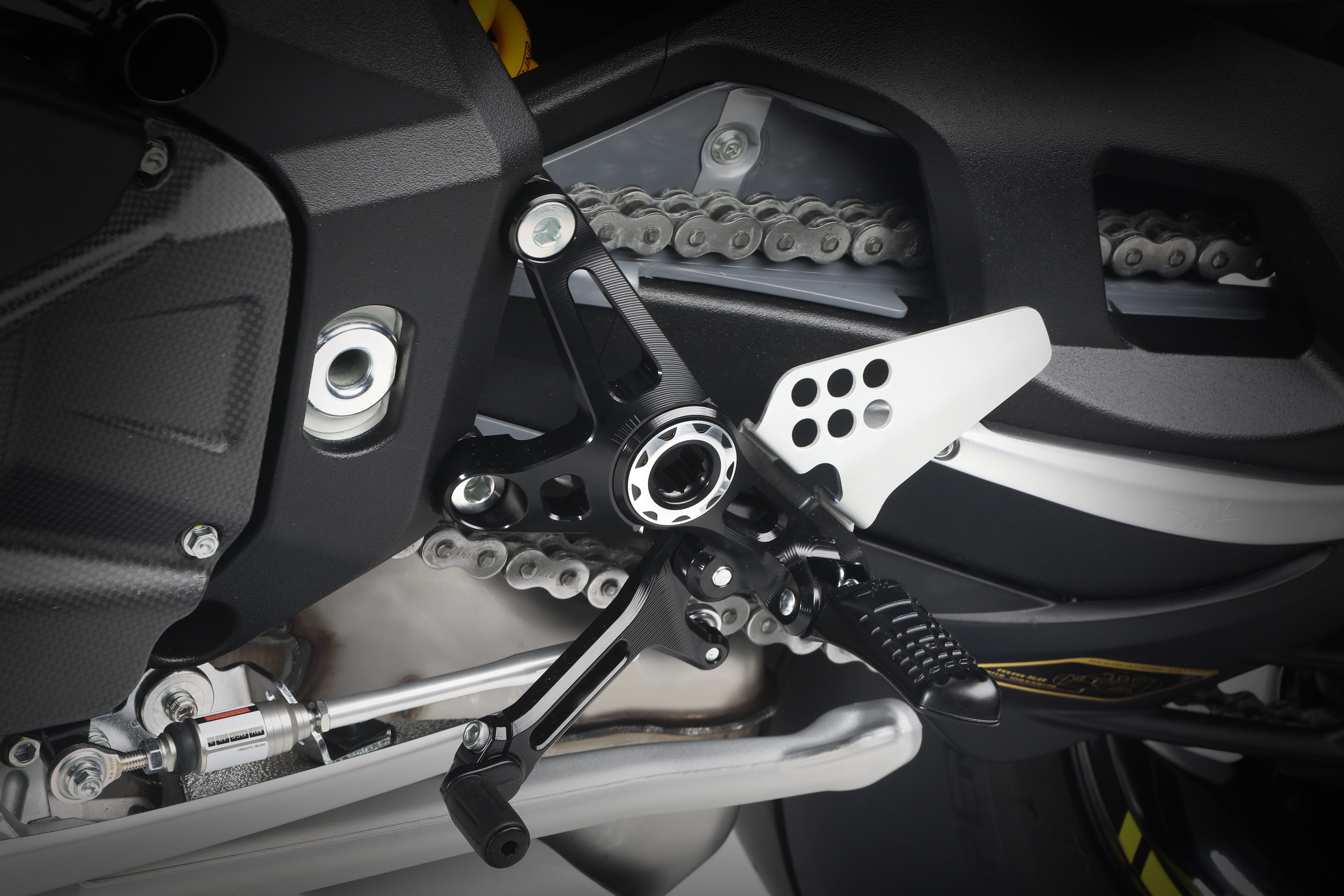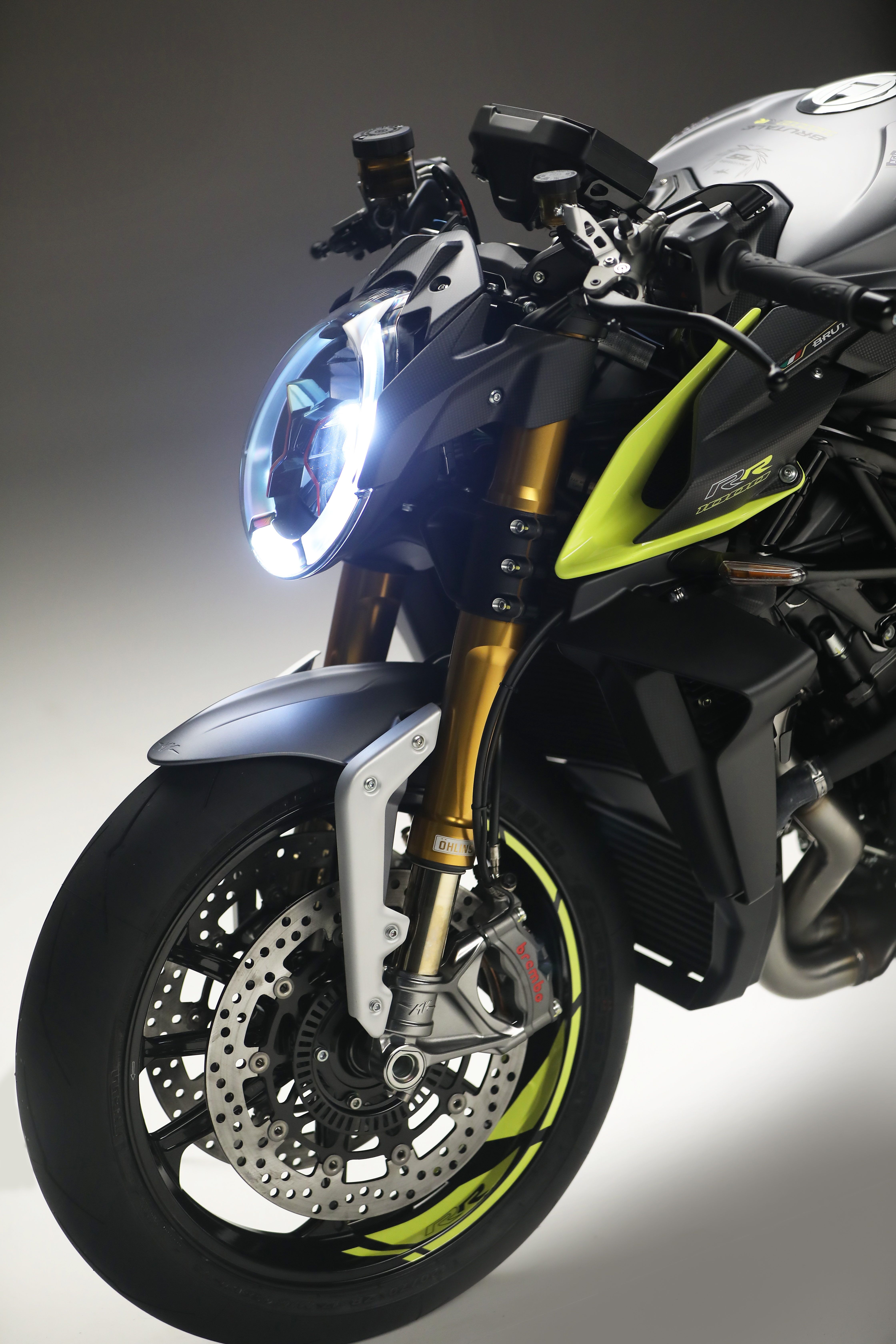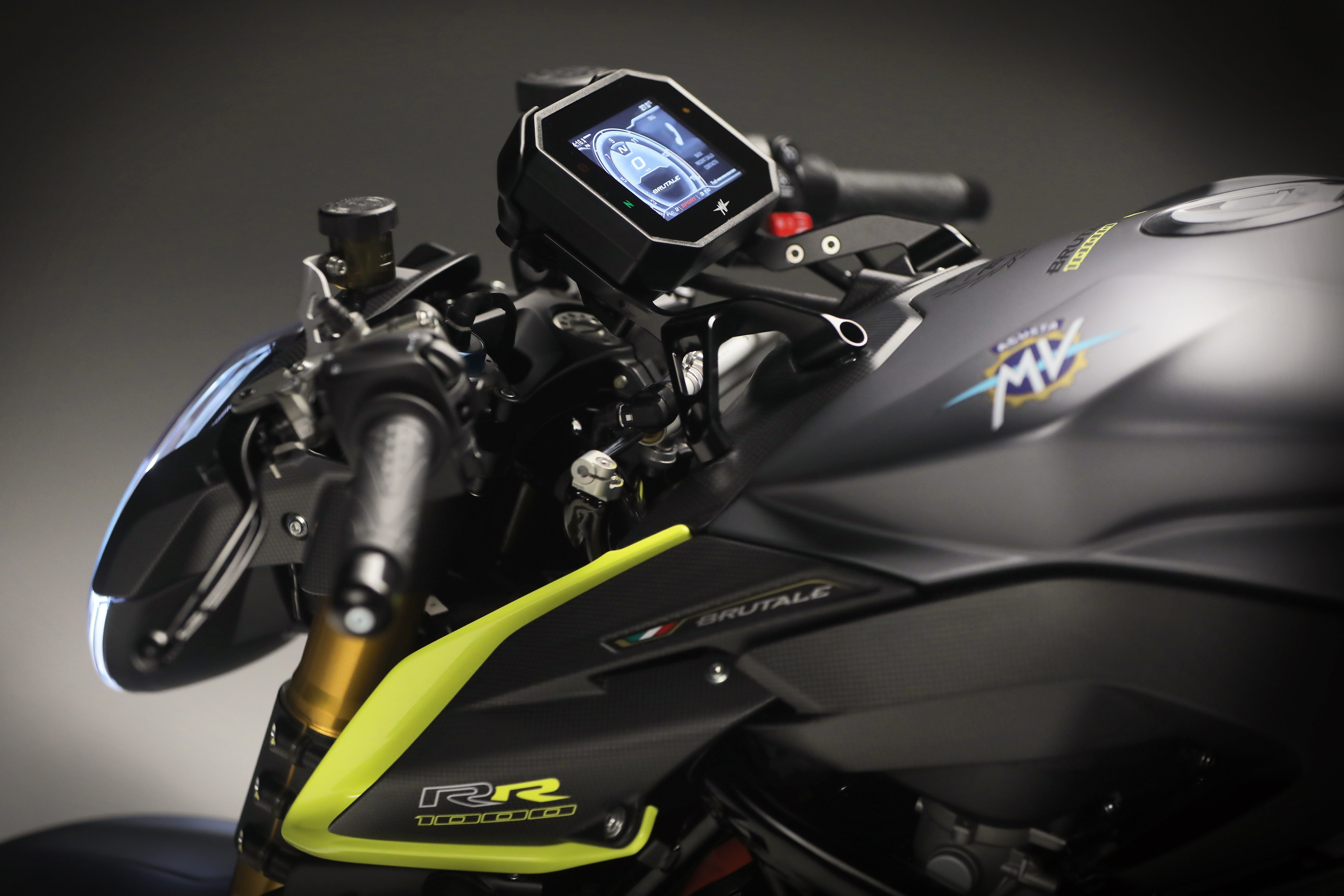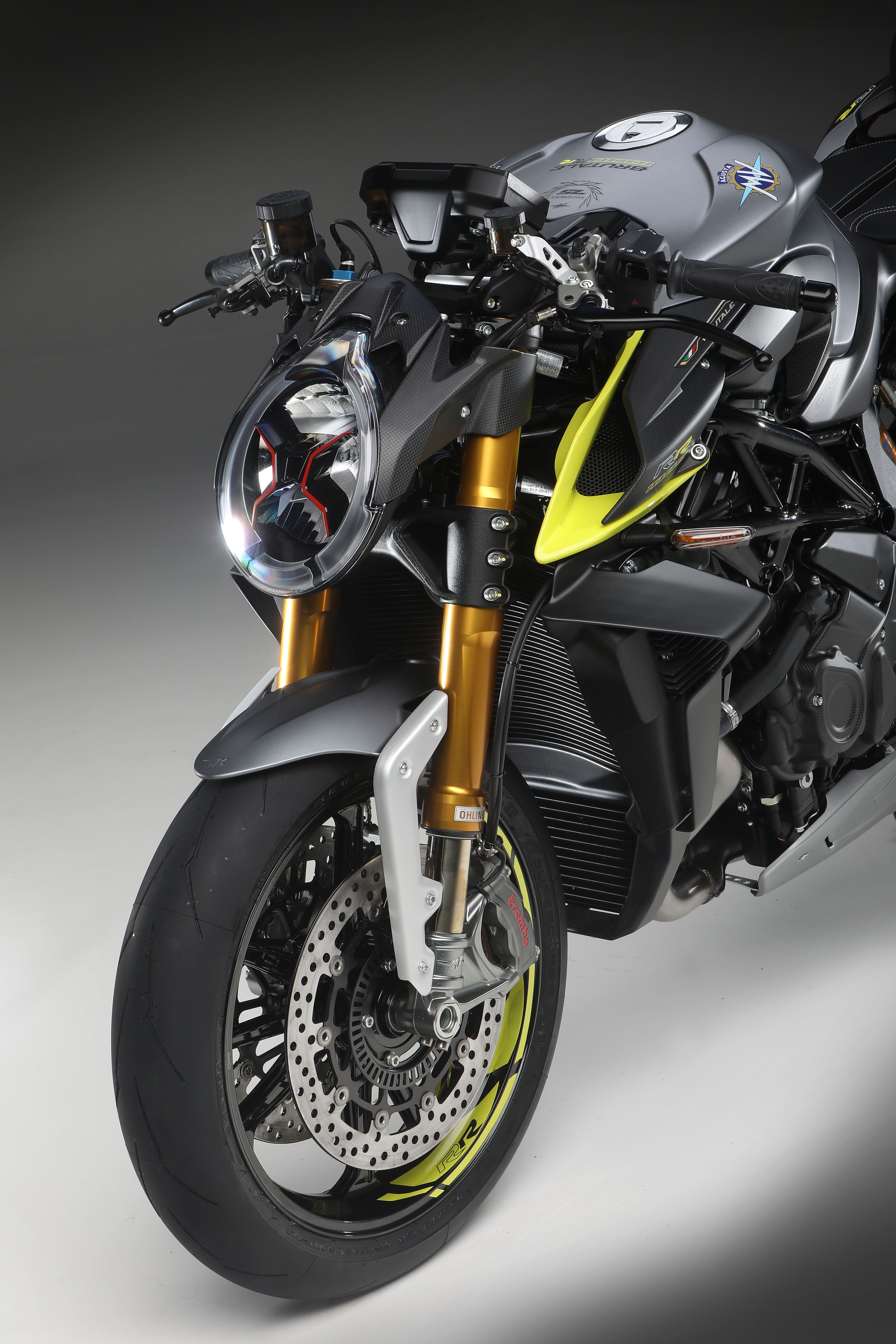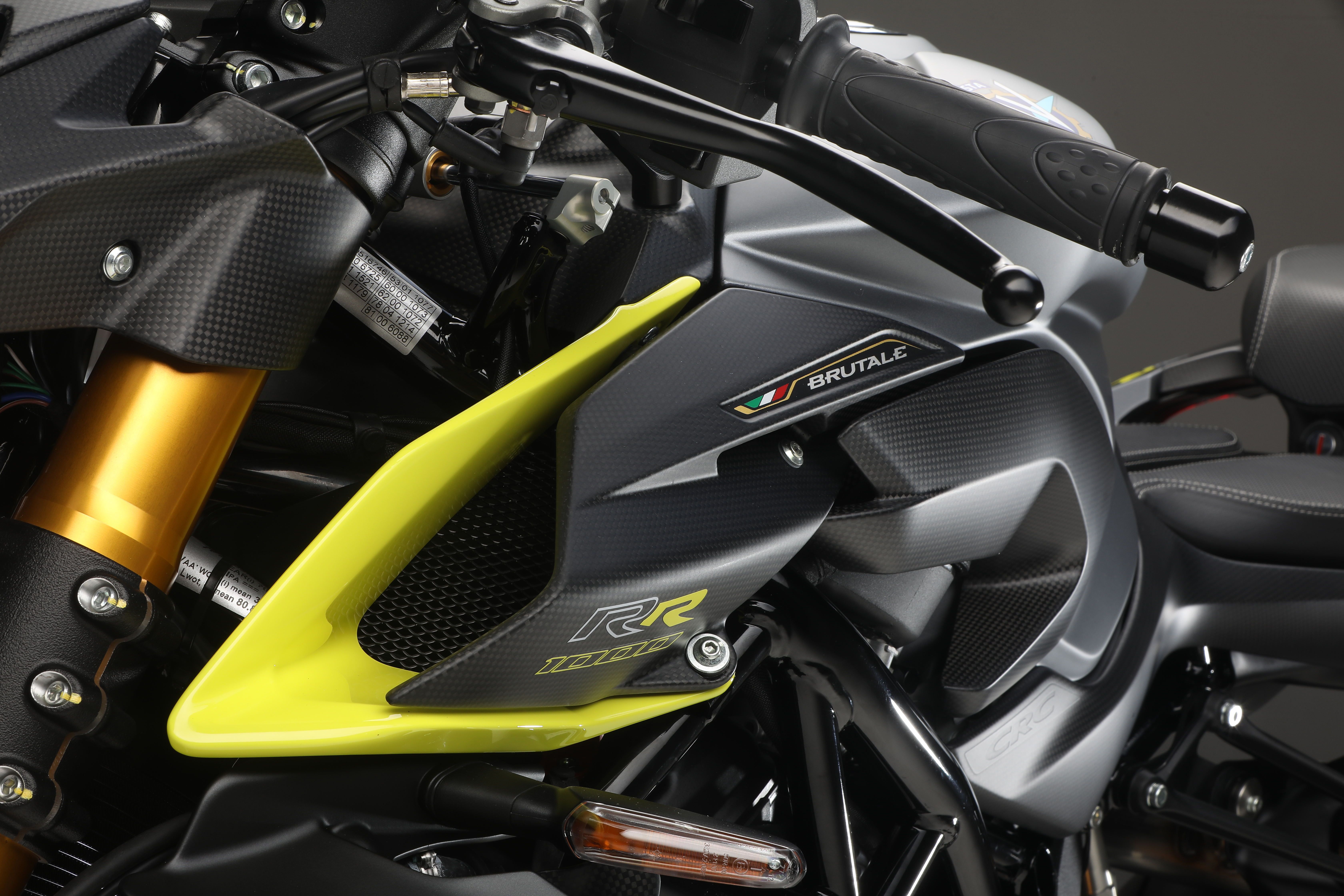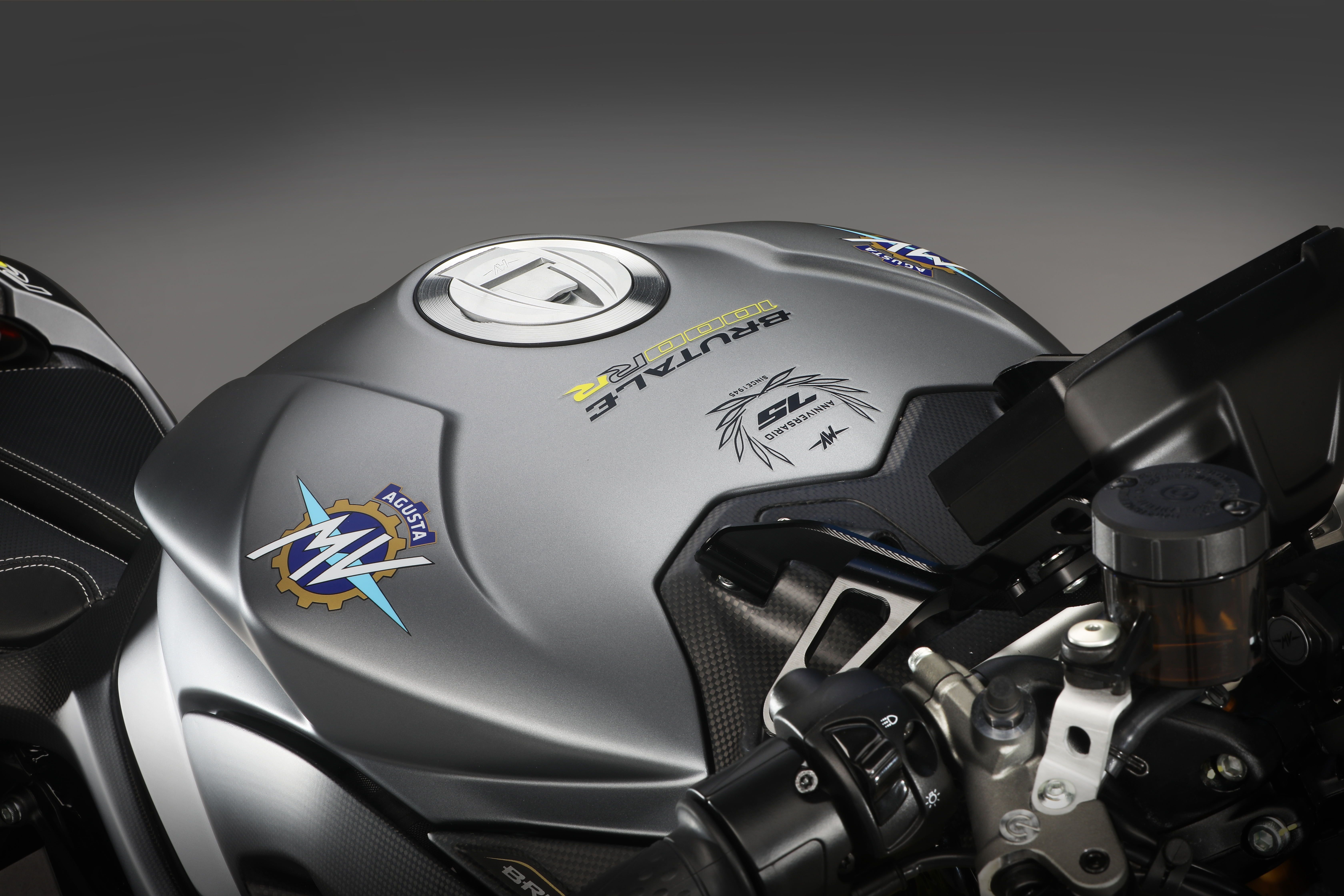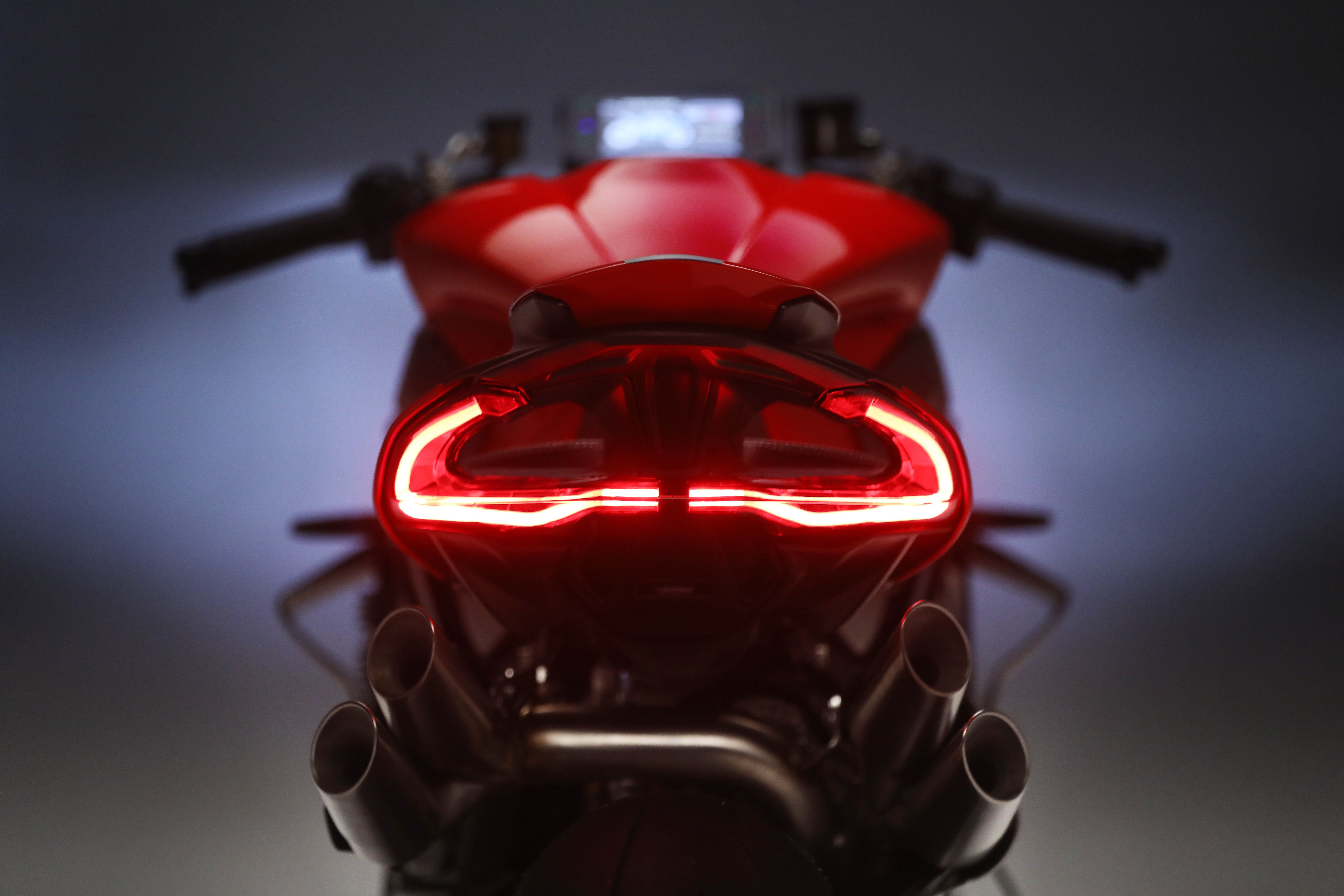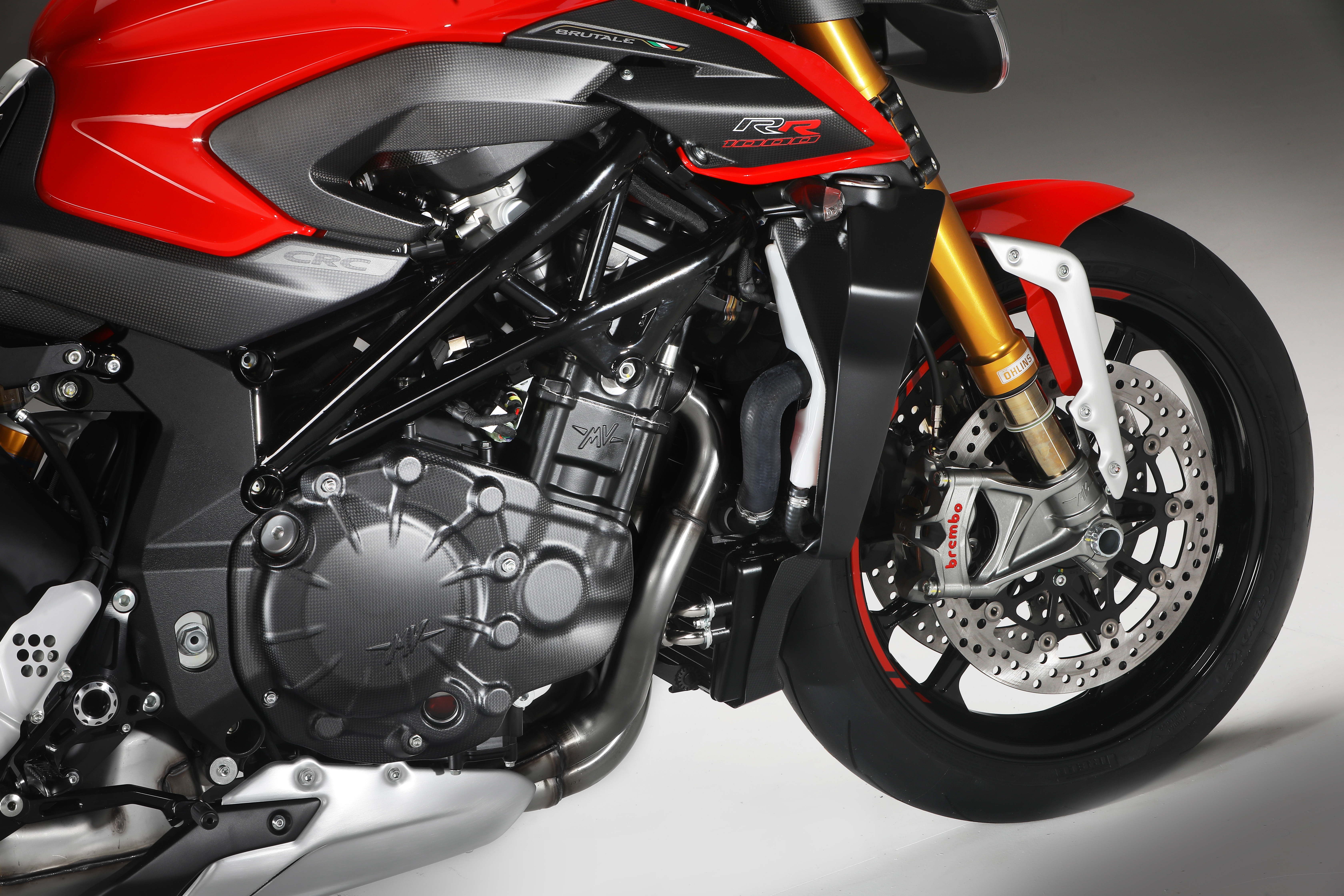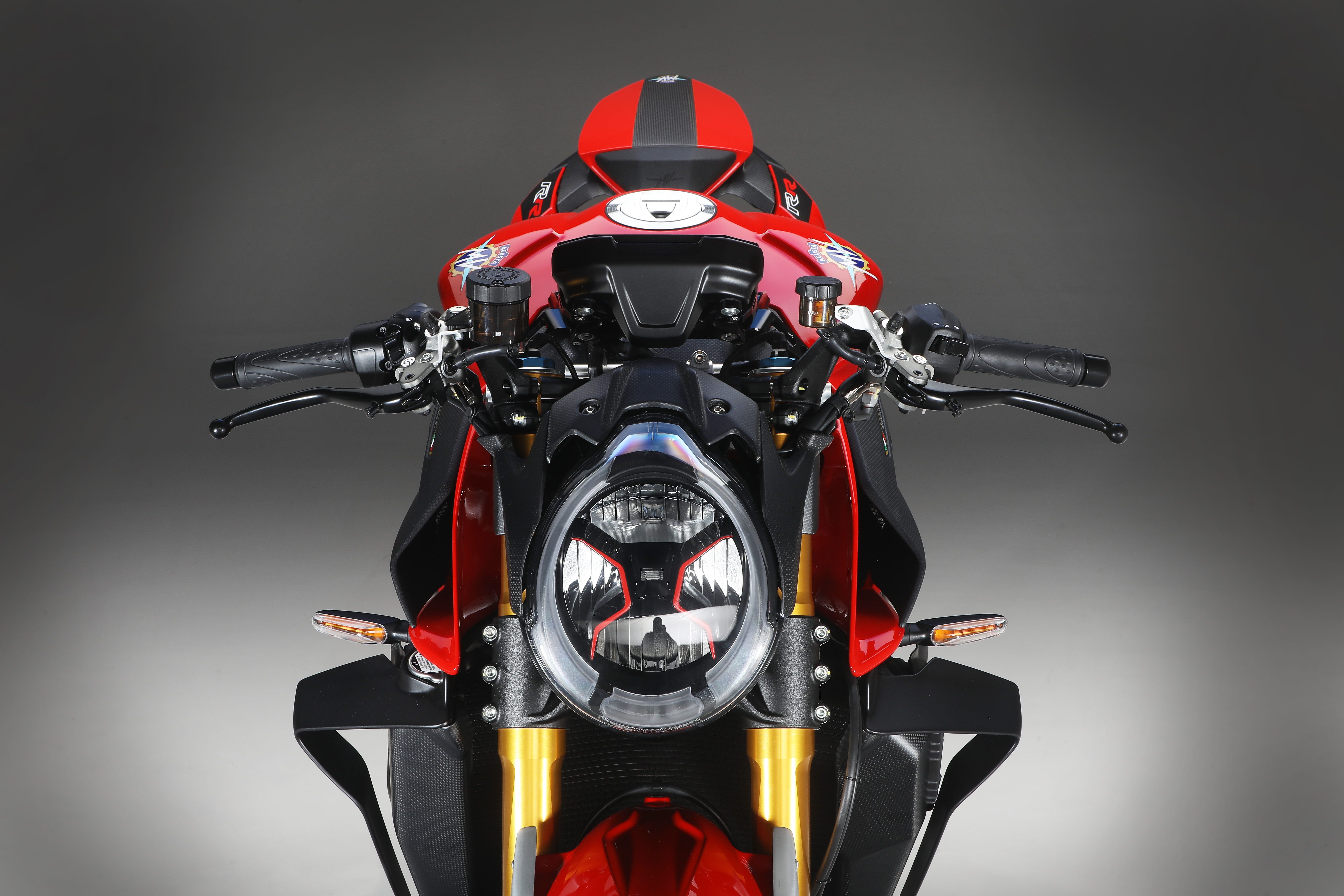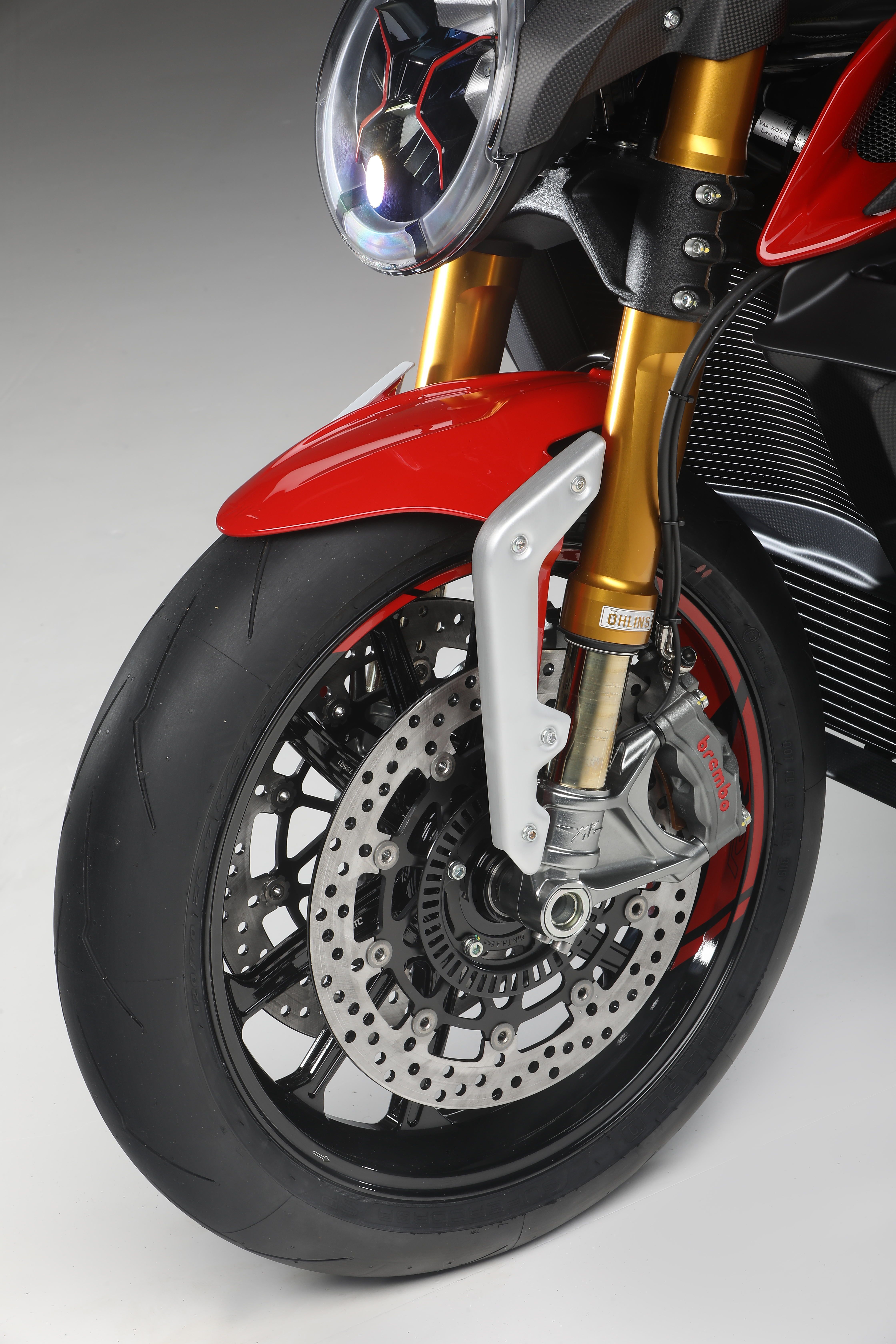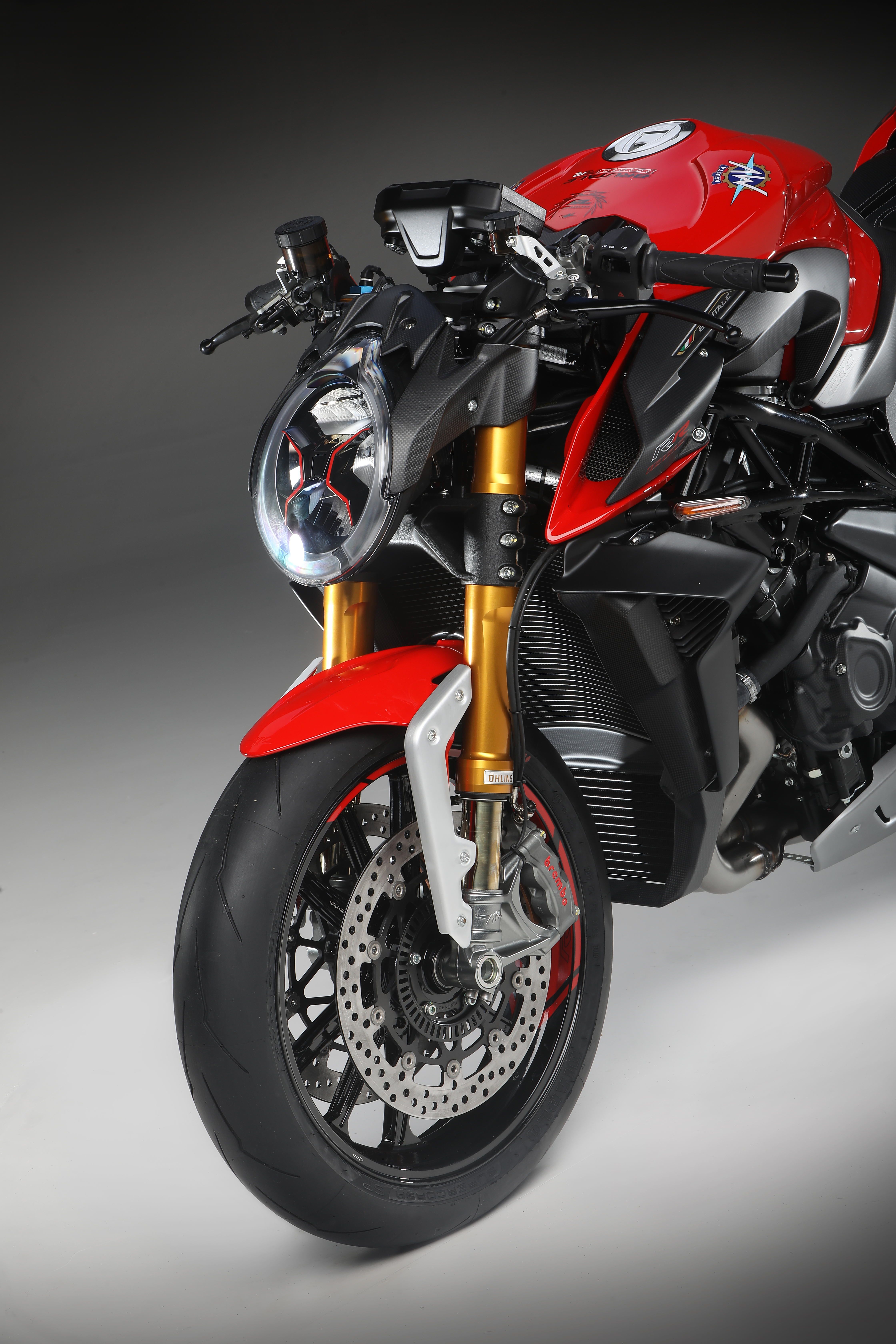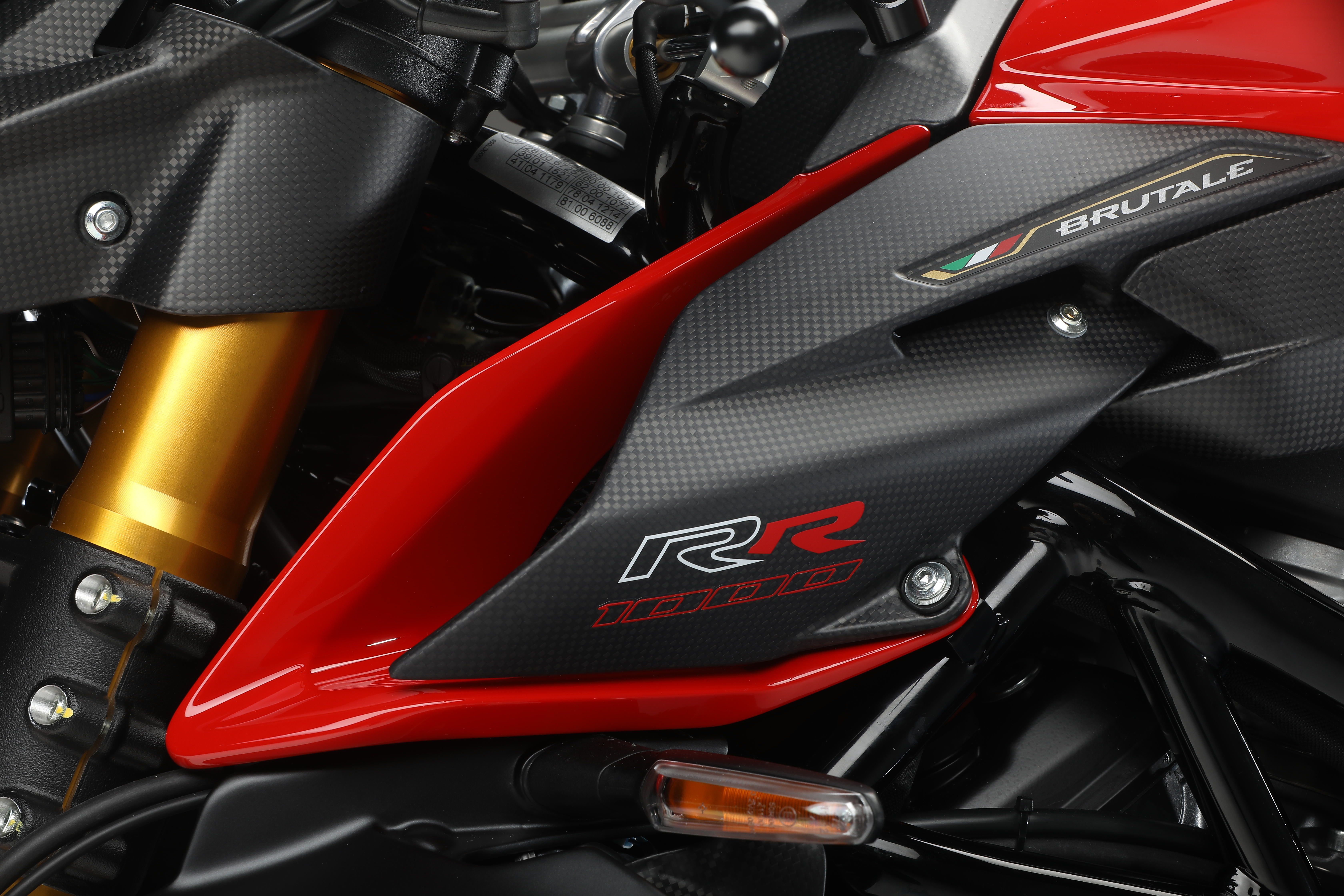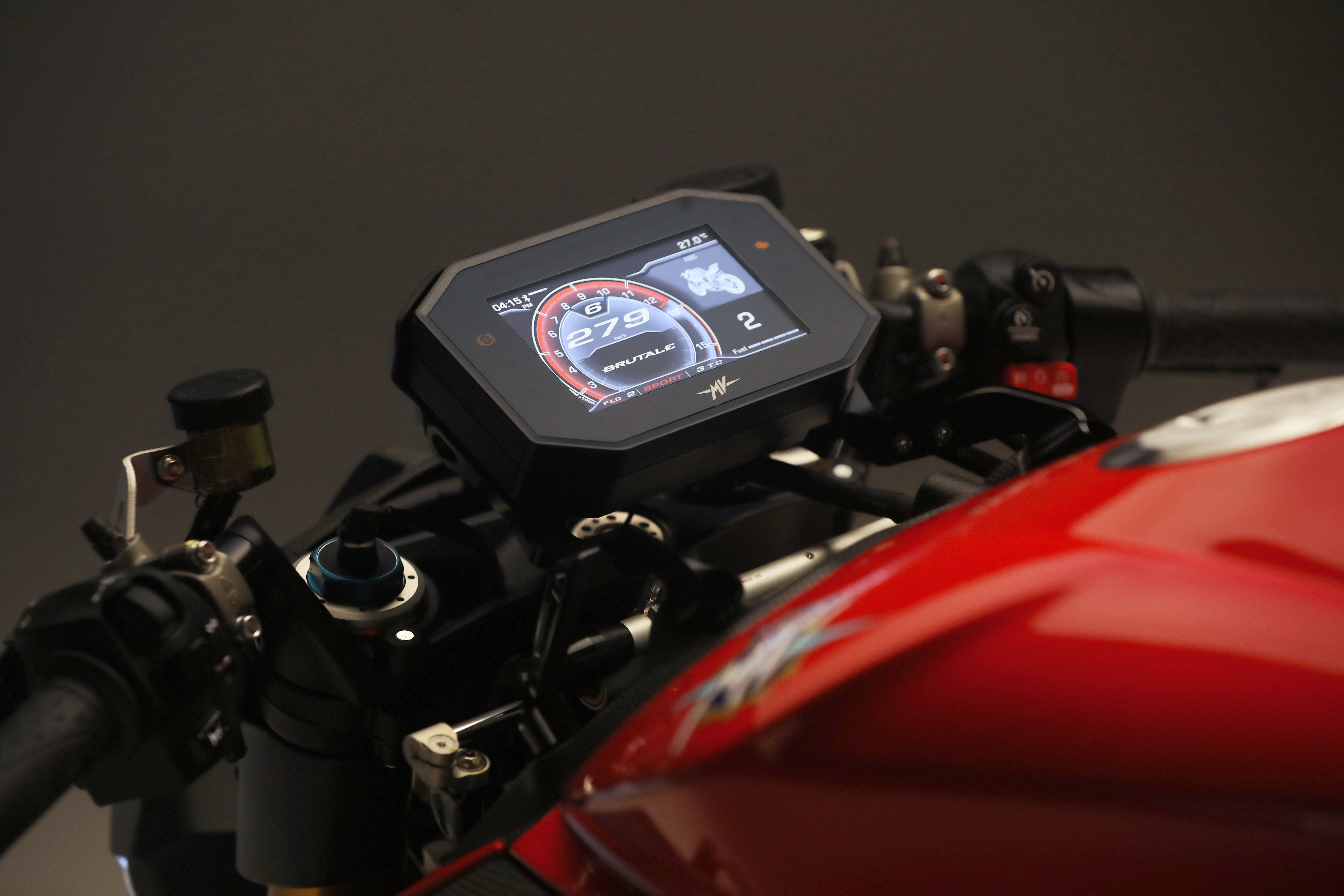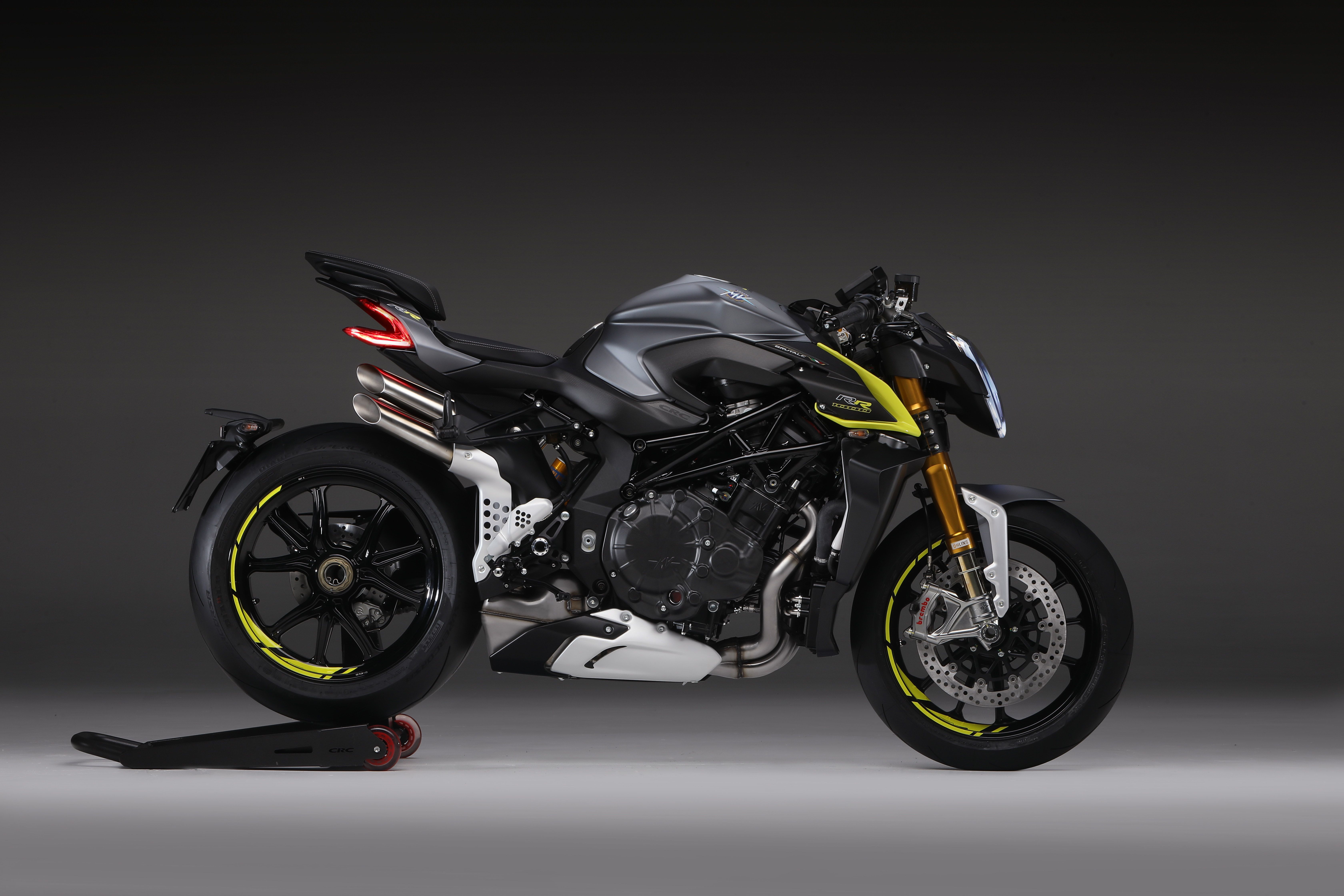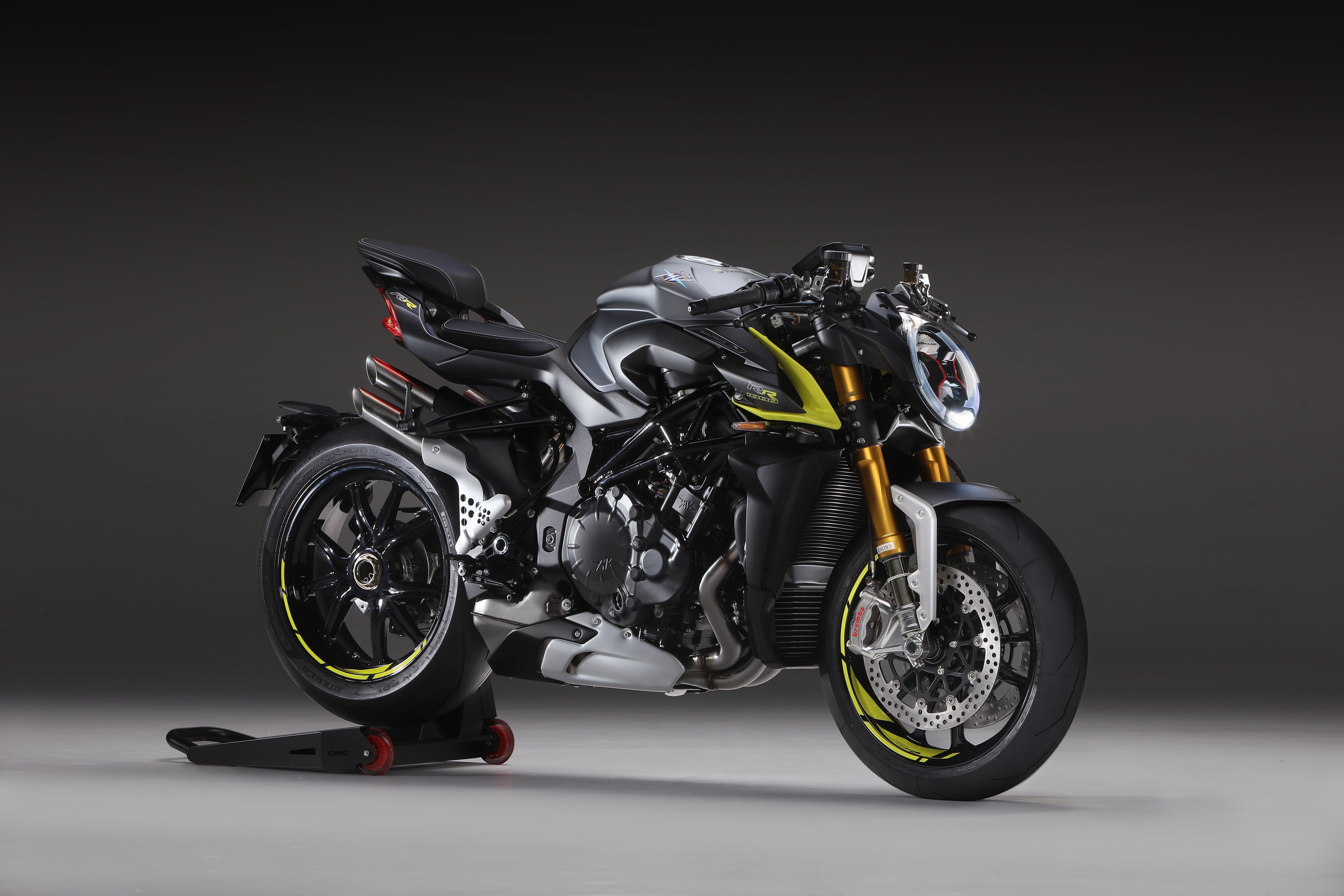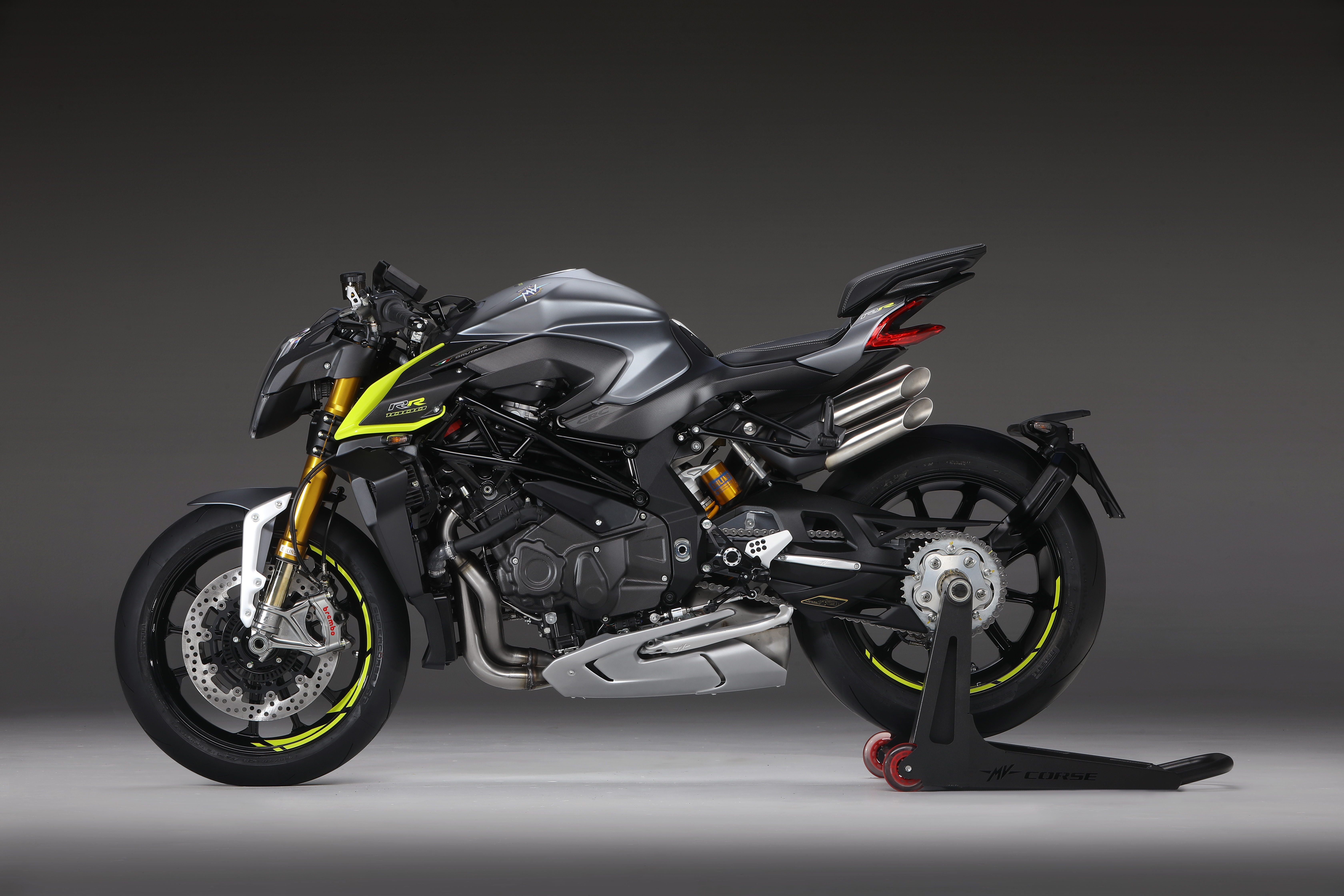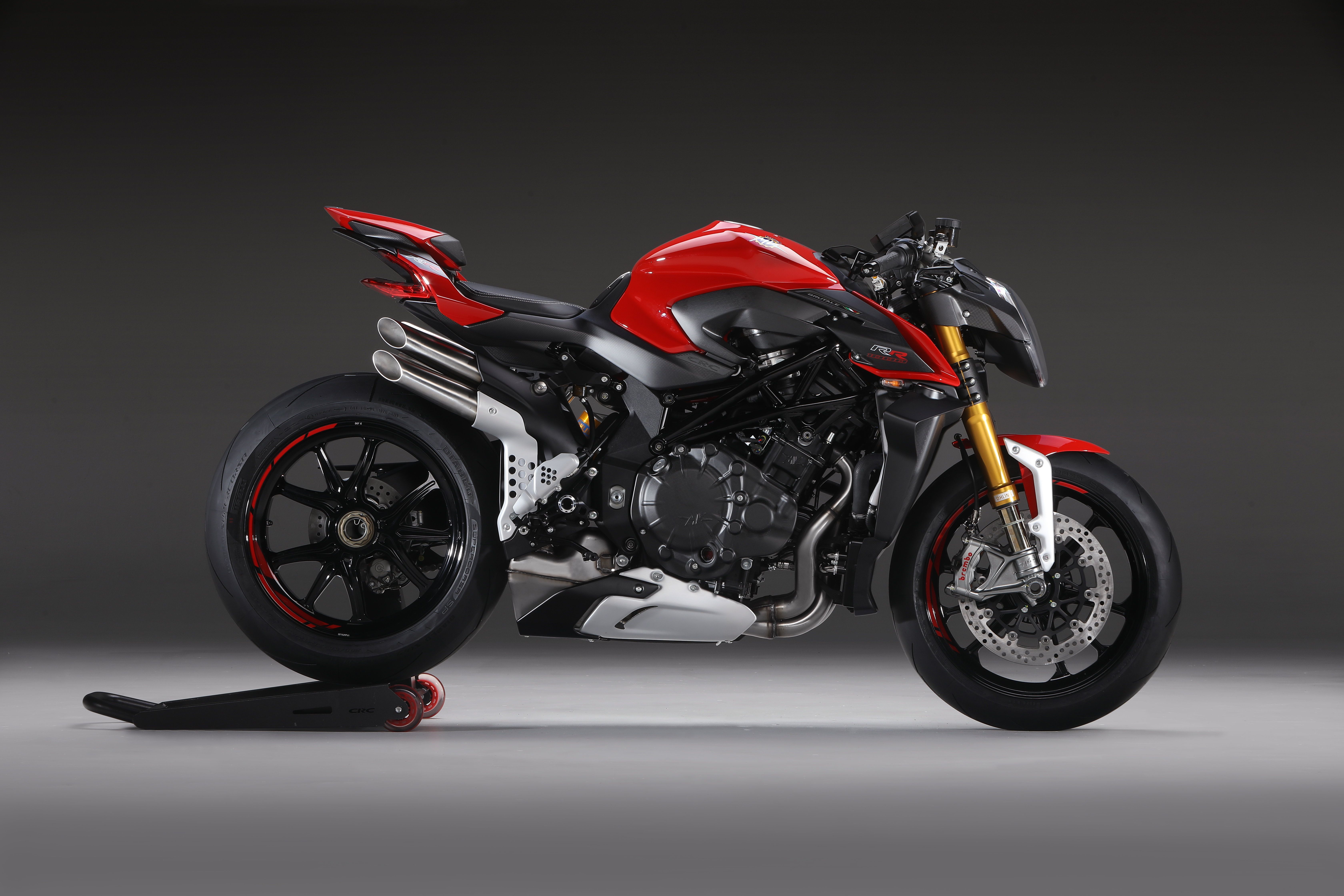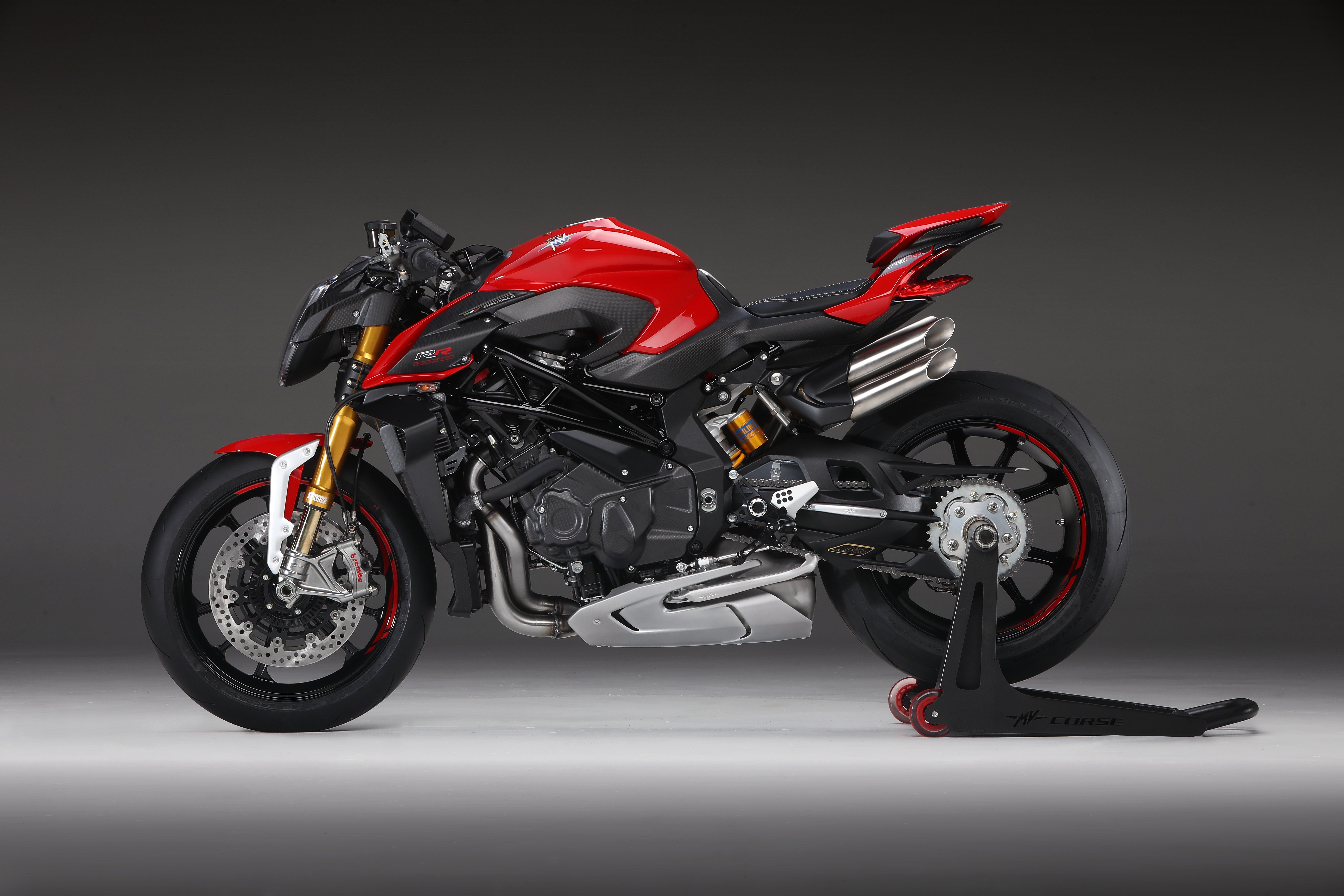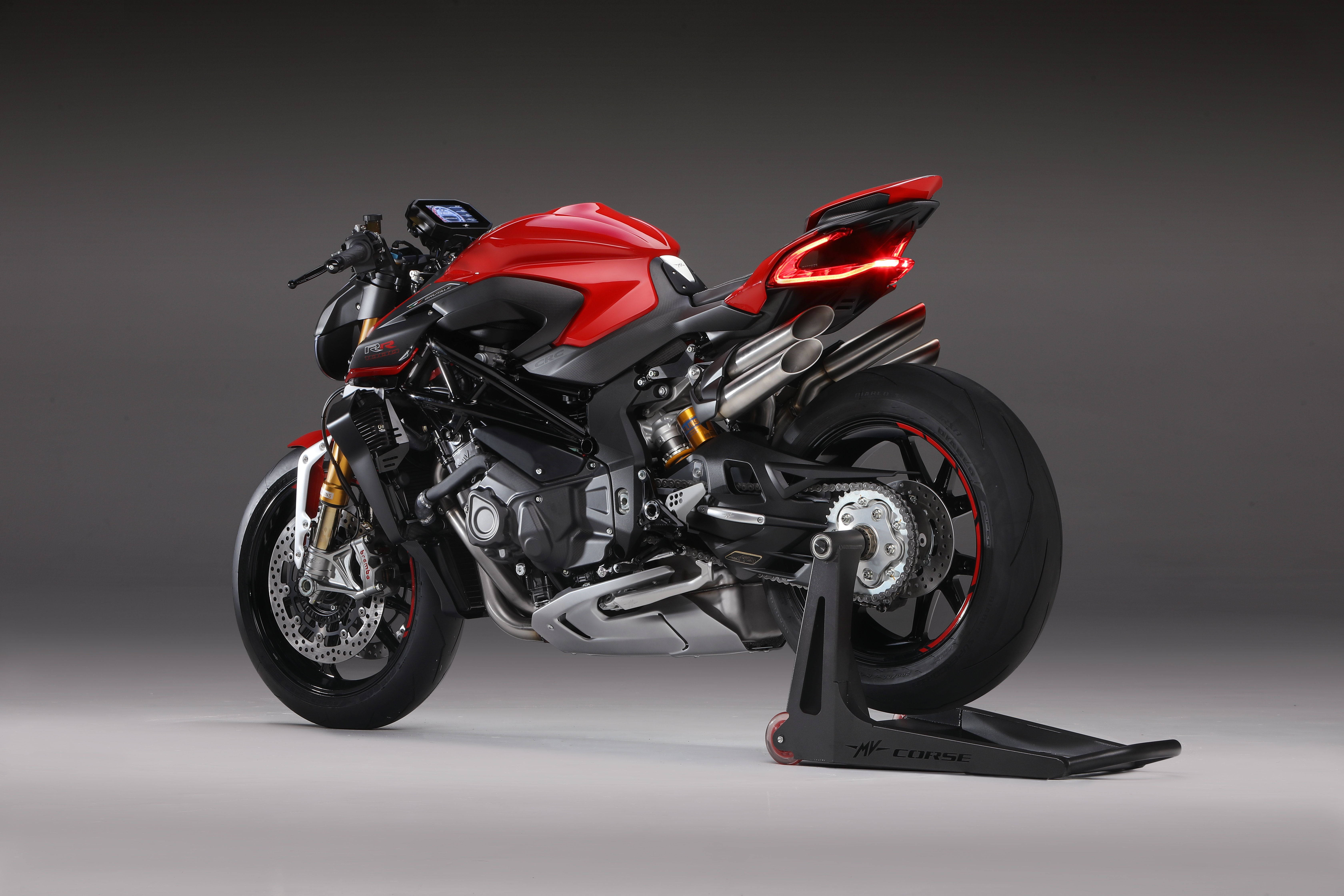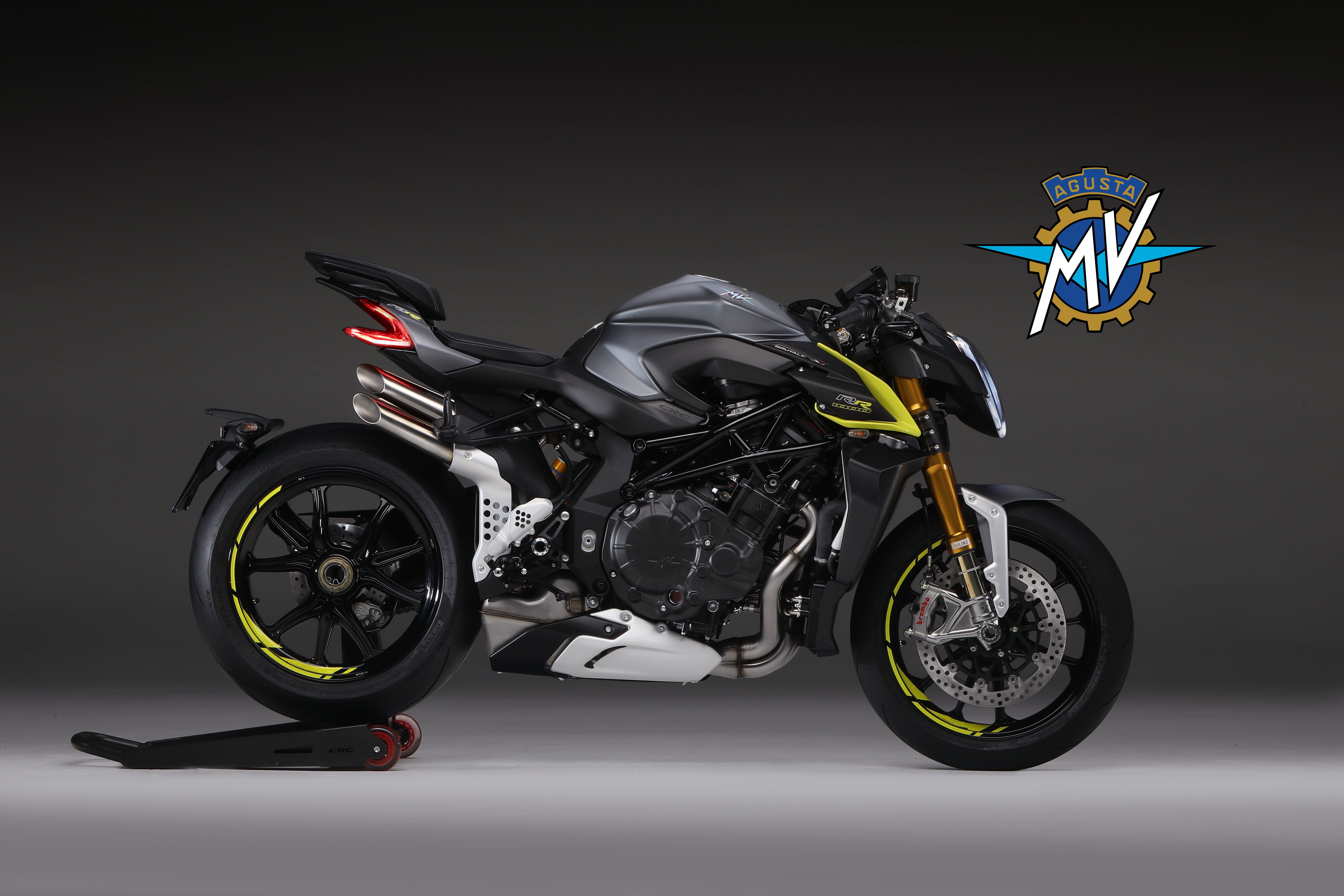Italian heavy MV Agusta fills out its hyper-naked range with its drag-tastic, new-for-2020 Brutale 1000RR. This new liter-sized Brutale follows the design characteristics established by its predecessors, and is absolutely saturated with performance-enhancing features and top-shelf electronics to make it a threat on both street and strip. Windtunnel-tested bodywork finishes the package in style and contributes to its overall speed and stability to show a synergy in the design that is somewhat rare for a street-legal machine.
2020 MV Agusta Brutale 1000RR
- Make: Array
- Model: 2020 MV Agusta Brutale 1000RR
- Engine/Motor: inline-4
- [do not use] Vehicle Model: Array
2020 MV Agusta Brutale 1000RR Design
The new Brutale 1000RR starts out with a front fender that, in my estimation, is actually cut down beyond the minimum dimensions for complete functionality, but it does prevent the upward fling that would otherwise find its way into your face. The fork foot-mount uprights carry a foil shape that splits the wind around the lower half of the inverted stanchions for low-resistance penetration at speed.
An oval headlight housing mounts multiple projectors for effective nighttime visibility, and it rocks a DRL band around the perimeter to ensure that you remain difficult to overlook, even in daylight. The Brutale carries nothing in the way of rider protection up top, not even a flyscreen for the instrument panel, but the angle on the face of the headlight suggests that it steers the air up and over the five-inch color TFT display. The display screen bundles all of the instrumentation together in one spot, plus it doubles as the rider interface for the safety and ride-quality electronics.
It's a naked design, so there is very little in the way of body covering, but what little it carries goes far beyond simple aesthetics. The radiator shroud presents a minimal profile, but viewed head-on, its secondary purpose becomes apparent. Inverted foil shaped “C wings” generate downward forces on the front end to help keep the front contact patch planted, though it does very little of that below the 120 mph (200 km/h) mark. This is much like the intake scoops incorporated with the cheek fairings that extend forward from the fuel tank. They do take advantage of the pressure wave at the front of the bike for a sneaky little boost to the volumetric efficiency, but the benefits mostly manifest themselves above the 100 mph mark.
Short-rise bars pull the pilot forward over the 4.23 U.S. gallon fuel tank. Since the rider's triangle is set up for drag racing and/or stoplight burning, there is no room to push yourself off to give your arms/shoulders/wrists a break, and that's worth remembering if you plan on using it as your everyday bike.
The solo seat rides 33.27 inches off the deck and is followed by a tail fairing that looks like it completely precludes the possibility of carrying a passenger. A split taillight pulls double duty as the rear turn signals, and the underside of the subframe and swingarm-mount hugger do their bit to contain the rear-wheel fling.
MV Agusta's motto is “motorcycle art,” and as grandiose as that statement may be, I find myself to agree. To be fair, the Italians have always had a passion for performance and an eye for aesthetics, but this new Brutale 1000RR is really some next-level stuff.
2020 MV Agusta Brutale 1000RR Chassis
Chrome-molybdenum steel tubing makes up the bulk of the Trellis-style frame on the Brutale 1000RR. The swingarm pivot plates are an aluminum alloy, and in true racebike fashion, they're adjustable to let you dial in the height of the front of the single-side aluminum swingarm.
Öhlins products handle all of the suspension duties. Out back, a progressive, EC TTX takes care of business with the full trinity of tweaks, and up front an Nix EC usd fork comes with same. To sweeten the deal, components at both ends are electronically controlled for easy, no-tool adjustments with the exception of the manually adjustable spring preload value up front.
Suspension travel is typical of a street machine at 4.72-inches, front and rear. Forged aluminum-alloy wheels round out the rolling chassis with 17-inches all around, and they come lined with a 120/70 and 200/55 on the front and rear, respectively, and of course the hoops sport a “Z” rating that means it will handle the stresses of actual drag-strip use. Though it's built for straight-line acceleration, the factory didn't neglect its cornering ability and so the front end rocks 3.82 inches of trail that'll make it eager enough in the bends.
This machine is capable of great acceleration and speed, so the factory didn't neglect the brakes, oh no. Dual 320 mm discs and four-piston, Brembo Stylema monobloc calipers haul down the front wheel with a 220 mm disc and twin-pot anchor to slow the rear. Bosch 9-Plus ABS comes with a Race Mode and a rear wheel lift-up prevention feature that'll help keep the rear contact patch planted, even under heavy front-brake actions.
2020 MV Agusta Brutale 1000RR Drivetrain
As striking as the Brutale 1000 RR is as a whole, it's still the beating heart that steals the show. It runs a massively over-square layout with a 79 mm bore and short, 50.9 mm stroke that gives the liquid-cooled four-banger its 998 cc total displacement. As you might expect, the compression ratio is smokin' hot at 13.4-to-1, so nothing but the highest octane content will do for fuel, but that's the trade off for the power it produces.
It's a high-revving engine that rocks strong-yet-lightweight titanium connecting rods to reduce reciprocating mass in the system. Plus, it utilizes a dry-sump lubrication that prevents oil stiction from sapping the inertia of the rotating components in the bottom end, even in turns and when pulling moonshots.
Dual over-head cams time four radial-mount poppets per cylinder for efficient aspiration, and the induction control falls to a quartet of throttle bodies that rock a pair of fuel injectors per unit. A Mikuni on bottom and a Magneti Marelli up top deliver precise fuel control and efficient fuel atomization. A ride-by-wire throttle grip sends its message to an Eldor EM2.10 engine control unit where the signal is modified by a four-track torque-control feature and eight-level traction control. A slip-and-assist clutch mitigates the risk of rear-wheel hop of hard downshifts and couples the engine power to the six-speed, cassette-style, constant-mesh transmission with a chain-type final drive.
Power figures are impressive. The mill churns out a whopping 208 horsepower at 13,000 rpm, and the torque maxes out at 11 grand even with 85 pound-feet of torque ready to be unleashed. Top speed is claimed to be greater than 186 mph (300 km/h).
|
Engine: |
Four cylinder, 4 stroke, 16 valve, “D.O.H.C”, radial valve |
|
Displacement: |
998 cc (60.9 cu. in.) |
|
Bore x Stroke: |
79 mm x 50.9 mm (3.1 in. x 2.0 in.) |
|
Compression ratio: |
13.4:1 |
|
Max. power (at the crankshaft): |
208 hp (153.0 kW) @ 13,000 rpm |
|
Max. torque: |
85.9 lb-ft (116.5 Nm) @ 11,000 rpm |
|
Starting: |
Electric |
|
Cooling system: |
Cooling with separated liquid and oil radiators |
|
Engine management system: |
Integrated ignition - injection system MVICS (Motor & Vehicle Integrated Control System) with eight injectors (4 lower fuel injectors by Mikuni + 4 upper fuel injectors by Magneti Marelli with increased fuel flow). Engine control unit Eldor EM2.10, throttle body full ride by wire Mikuni, pencil-coil with ion- sensing technology, control of detonation and |
|
misfire - Torque control with four maps - Traction control with 8 levels + off and wheelie control with inertial platform |
|
|
Electronic quick-shift: |
MV EAS 2.1 (Electronically Assisted Shift Up & Down) |
|
Clutch: |
Wet, multi-disc with back torque limiting device and Brembo radial pump/lever assembly |
|
Transmission: |
Cassette style; six speed, constant mesh |
|
Primary drive: |
48/82 |
|
Gear ratio: |
First: 14/37, Second: 16/33, Third: 18/31, Fourth: 20/30, Fifth: 22/29, Sixth: 21/25 |
|
Final drive ratio: |
16/41 |
2020 MV Agusta Brutale 1000RR Pricing
It's unclear if this impressive machine will make its way to our side of the pond, but our European brothers and sisters can expect for fork over 29,990€ if they want to ride one of these home.
|
Fairing Material: |
Carbon fiber and thermoplastic material |
|
Exclusive features: |
Light crankshaft - New combustion chamber, Titanium bolts, screws, and fasteners -Titanium connecting rods - Dashboard TFT 5”color display - Cruise control - Bluetooth – GPS App MVride for navigation mirroring, app-controlled engine, suspension and rider aids setup - Launch Control - FLC Front lift control, Immobilizer |
|
Color: |
Ago Red/Dark Metallic Matt Grey/ Matt Carbon, Metallic Avio Grey/Fluo Yellow/Dark Metallic Matt Grey/Matt Carbon |
|
Price: |
29,990€ |
2020 MV Agusta Brutale 1000RR Competitors
With such a radical style and powerful engine, I knew I had to come up with a fairly serious competitor, and it seems like Ducati's Monster 1200S might fit the bill fairly well and appeal to the same sort of rider.
Ducati Monster 1200 / 1200 S
Like the Brutale 1000 RR, the Monster wastes not an ounce on superfluous body panels, so it too comes off the showroom as naked as a jaybird. I've said it before and I'll say it again; it's hard to beat the passion and eye for style the Italians bring to the table, so both entries are beautiful in their own right even though the Ducati is somewhat less radical looking.
One thing that's missing on the Monster is the C-wing feature that provides extra stability for the Brutale at speed, so aesthetics aside, the Duc falls behind a bit in that respect. The Monster gets some back with its stock pillion equipment, so at least you can share the fun with a friend if you like.
Ducati floats its ride on fully-adjustable suspension components, but again falls short of the MV Agusta's electronic wizardry as it has manual adjustments only. The Monster rolls with corner-sensitive ABS and other safety gear to include traction control, wheelie control, and riding modes, but it looks like the RLM system can only be found on the Brutale.
A Testastretta L-twin powers the Duc with its signature Desmodromic valve timing that uses a pull-closed cam instead of valve springs to shut the poppets. That is supposed to make it safer to operate at high revs, but the Brutale's inline-four outrevs the Duc's 9,250 redline by a significant margin at 13 grand, so it looks like the fancy valvetrain doesn't gain Duc very much in this case.
As for power, the Monster's mill churns out 147 horsepower and 91 pound-feet of torque against 208/85 in a lopsided trade off. There's another trade off to be had, this one at the checkout. Ducati lets go of its Monster 1200 S for 19,500€, a price that leaves a wide gulf between it and the Brutale's 29,990 sticker.
Read our full review of the Ducati Monster 1200 / 1200 S.
He Said
“Wow, just wow. This bike has a lot to offer. Gobs of power and a metric tonne of curb appeal, it's bound to appeal to some well-heeled riders out there. While you'll never do it justice on public roads – the Autobahn is a notable exception – you don't necessarily have to get the most out of it. Just knowing that you can blow the doors off anything else on the road can be enough blow the doors off anything else on the road can be enough}}.”
She Said
My wife and fellow motorcycle writer, Allyn Hinton, says, “Nobody can make a beautiful bike like an Italian can. There's just something artistic in every aspect of the bike. It's top-notch with the engine out of the F4. Here's two little tidbits for you. Every Brutale 1000RR is hand-assembled and signed by a single technician, and it's the first fully connected motorcycle controlled through the MVRide app.”
2020 MV Agusta Brutale 1000RR Specifications
|Engine & Drivetrain:||
|
Engine: |
Four cylinder, 4 stroke, 16 valve, “D.O.H.C”, radial valve |
|
Displacement: |
998 cc (60.9 cu. in.) |
|
Bore x Stroke: |
79 mm x 50.9 mm (3.1 in. x 2.0 in.) |
|
Compression ratio: |
13.4:1 |
|
Max. power (at the crankshaft): |
208 hp (153.0 kW) @ 13,000 rpm |
|
Max. torque: |
85.9 lb-ft (116.5 Nm) @ 11,000 rpm |
|
Starting: |
Electric |
|
Cooling system: |
Cooling with separated liquid and oil radiators |
|
Engine management system: |
Integrated ignition - injection system MVICS (Motor & Vehicle Integrated Control System) with eight injectors (4 lower fuel injectors by Mikuni + 4 upper fuel injectors by Magneti Marelli with increased fuel flow). Engine control unit Eldor EM2.10, throttle body full ride by wire Mikuni, pencil-coil with ion- sensing technology, control of detonation and |
|
misfire - Torque control with four maps - Traction control with 8 levels + off and wheelie control with inertial platform |
|
|
Electronic quick-shift: |
MV EAS 2.1 (Electronically Assisted Shift Up & Down) |
|
Clutch: |
Wet, multi-disc with back torque limiting device and Brembo radial pump/lever assembly |
|
Transmission: |
Cassette style; six speed, constant mesh |
|
Primary drive: |
48/82 |
|
Gear ratio: |
First: 14/37, Second: 16/33, Third: 18/31, Fourth: 20/30, Fifth: 22/29, Sixth: 21/25 |
|
Final drive ratio: |
16/41 |
|Chassis:||
|Frame:|CrMo Steel tubular trellis|
|Rear swing arm pivot plates material:| Aluminum alloy - Adjustable swingarm pivot height|
|Steering damper:| Öhlins EC with electronic manual and automatic adjustment modes|
|Rider’s footpegs:| CNC adjustable height|
|Front Suspension:| 43 mm (1.69 in.) Öhlins Nix EC hydraulic “upside down” front forks with TiN superficial treatment. Completely adjustable with electronically controlled compression and rebound damping with manually controlled spring preload.|
|Fork travel:| 4.72 in.(120 mm)|
|Rear Suspension:|Progressive, single shock absorber Öhlins EC TTX completely adjustable with electronically controlled compression and rebound damping and spring preload|
|Single sided swing arm material:| Aluminum alloy|
|Wheel travel:| 4.72 in.(120 mm)|
|Front brake:| Double floating disc with Ø 320 mm (Ø 12.6 in.) diameter, with steel braking disc and aluminum flange - Brembo radial pump/level assembly, Brembo Stylema radial-type caliper, single-piece with 4 pistons Ø 30 mm (Ø 1.18 in.)|
|Rear brake:| Single steel disc with Ø 220 mm (Ø 8.66 in.) dia.- Brembo PS13 brake pump, Brembo caliper with 2 pistons Ø 34 mm (Ø 1.34 in.)|
|ABS System:| Bosch 9 Plus with Race Mode and RLM (Rear wheel Lift-up Mitigation)|
|Front Wheel:| Material/size Forged aluminum alloy 3,50 ” x 17 ”|
|Rear Wheel:| Material/size Forged aluminum alloy 6,00 ” x 17 ”|
|Front Tire:|120/70 - ZR 17 M/C (58 W)|
|Rear Tire:|200/55 - ZR 17 M/C (78 W)|
|Electrical:||
|Voltage:| 12 V|
|Alternator:| 350 W @ 5000 rpm|
|Battery:| Li-ion 12 V - 4.0 Ah|
|Dimensions & Capacities:||
|Wheelbase:| 55.71 in.(1,415 mm)|
|Overall length:| 81.89 in.(2,080 mm)|
|Overall width:| 31.69 in.(805 mm)|
|Saddle height:| 33.27 in.(845 mm)|
|Min. ground clearance:| 5.55 in.(141 mm)|
|Trail:| 3.82 in.(97 mm)|
|Dry weight:| 410.06 lbs.(186 kg)|
|Fuel tank capacity:| 4.23 gal.(16 l)|
|Fuel Economy:|35 mpg (6.7 l/100 km)|
|Maximum speed:| over 186 mph (300 km/h)|
|Details:||
|Fairing Material:| Carbon fiber and thermoplastic material|
|Exclusive features:| Light crankshaft - New combustion chamber, Titanium bolts, screws, and fasteners -Titanium connecting rods - Dashboard TFT 5”color display - Cruise control - Bluetooth – GPS App MVride for navigation mirroring, app-controlled engine, suspension and rider aids setup - Launch Control - FLC Front lift control, Immobilizer|
|Color:| Ago Red/Dark Metallic Matt Grey/ Matt Carbon, Metallic Avio Grey/Fluo Yellow/Dark Metallic Matt Grey/Matt Carbon|
|Price:|29,990€|
Further Reading
MV Agusta
Read more MV Agusta news.

